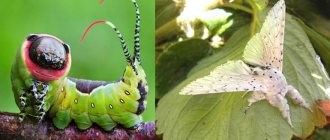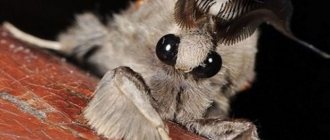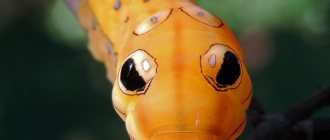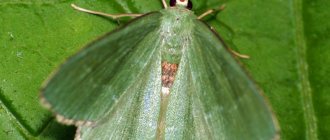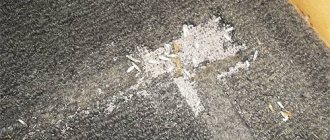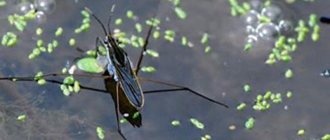Description, appearance and body structure
A caterpillar is the larva of lepidopteran insects, namely butterflies, moths and moths. Its body is oblong, segmented, its soft shell provides maximum mobility. Caterpillars, like their adult sexually mature individuals, belong to the class of insects.
Their body consists of a barely visible head, thoracic and abdominal sections, and several pairs of limbs. In appearance, the body structure of the caterpillar resembles a worm. The size of a butterfly or other insect larva can vary from 10 mm to 12 cm.
In the front part of the caterpillar there is a head, which consists of six fused segments that form a hard capsule. In most cases it is round. The parietal parts of the insect protrude above the head, forming a kind of horns. Small antennae grow on the sides, consisting of three successive joints. Butterfly larvae have 5-6 pairs of eyes. Usually they are located one after another in an arcuate manner.
Body structure
The mouthparts of this insect are of the gnawing type. The upper jaws are well developed and have teeth that easily gnaw and tear food. Inside the oral cavity there are tubercles for chewing food. Insects breathe using a spiracle, which is located on the chest and represents a stigma.
Most butterfly caterpillars have three pairs of legs in the chest area, and five pairs of prolegs, which are located in the abdominal region. At the ends of the first there are soles with claws, which insects extend during movement. The latter are equipped with small hooks that help them stay on the plant. In general, moth and moth caterpillars look like butterfly caterpillars. Their size and shade of the body may vary.
The insect's body is covered with small villi, outgrowths, and a well-grown cuticle. In this case, the bristles are arranged in a certain order inherent in a given species or family of insects.
To transform the larva into a mature flying individual, each caterpillar contains immaginal discs, which are the rudiment of future wings, articulated paws and compound eyes. In the process of further development of the insect, their transformation occurs.
What do caterpillars and their larvae eat?
The caterpillar, hatched from the egg, first of all eats its shell, inside which it developed. Most of these creatures are herbivores; they feed on leaves and plant fruits. But there are also predators that eat sedentary insects, scale insects. Unlike butterflies, these insects eat solid food and therefore have strong gnawing jaws. The upper jaw is more powerful; there are teeth with which it chews food.
Insects consume leaves in such a way that it is easy to determine which larvae fed there. Small-sized individuals gnaw only the upper or lower part of the leaf. They leave transparent slits of intact thin skin.
Due to the fact that the hatched larvae immediately begin to feed heavily, the integument, which does not stretch, soon becomes small. The insect is forced to stop feeding for a while and shed its skin. During its life, the caterpillar molts 4-5 times.
Habitat
The limited mobility of caterpillars does not facilitate their movement over long distances. In most cases, insects lead a terrestrial lifestyle, but there are also species that live in water.
All caterpillars are divided into two main groups: hidden and leading a free lifestyle. The former practically do not appear on the surface and live in the bark or in the ground away from sunlight. The latter are found on plants and are active during the daytime.
Habitat
In nature, many insects and animals feed on caterpillars. This is due to their high protein content. Therefore, the color of insects living on plants has a camouflage color, which allows them to blend in with the surface of the leaves. Poisonous butterfly larvae are characterized by a frightening bright body shade.
Among those who eat caterpillars:
- wasps;
- spiders;
- birds;
- reptiles.
To protect themselves from attacks from predators, some butterfly larvae are capable of producing a whistle and protruding from their body a fork-shaped gland of a red-orange hue, which secretes mucus with a pungent odor.
What are the legs of a butterfly hives for?
And how many walking legs a urticaria butterfly has can be determined by carefully examining it.
The butterfly's chest is divided into three segments, each of which carries its own pair of legs. Butterflies have six of them in total. But the anterior pair in some species are vestigial processes.
Such butterflies use only four legs as walking legs. True, it should be noted that in all of them they serve to a greater extent only for fastening to the surface, and not for walking, so they are equipped with a large number of special devices. And many butterflies also have taste buds on their legs. And the insect will not start eating until it touches the sweet nectar with its limbs.
Types of caterpillars
In nature, there are many types of caterpillars that differ in size, color and other features. However, only a few of them have become more widely known.
Among them:
- Cabbage caterpillar. The insect's habitat is Eastern Europe, from North Africa to the Japanese islands. Subsequently it came to South America, where it was introduced. This green caterpillar is the larva of the cabbage butterfly. The length of its body is about 3.5 cm. The insect has 8 pairs of limbs. On the surface of the body there are black warts and short hairs of the same color.
- Moth caterpillar. The insect has an elongated body. Its peculiarity is its underdeveloped abdominal limbs, so it moves in a loop-like manner, bending the body in an arc. This makes it possible to move the back of the body forward. The color of the moth larva can be green or brown, depending on the variety.
- Large harpy larva. It lives in Europe, Central Asia, and northern Africa. The length of adult individuals reaches 6 cm. The color of insects is green with a purple diamond on the back, which has a light outline.
- Redtail caterpillar. Distributed in the forest-steppe of Eurasia, as well as Asia. It grows up to 5 cm in length. It can have a pink, brown or gray color. The body of the insect is densely covered with hairs, and at the end of the body there is a tail from which crimson bristles protrude. This species belongs to the category of poisonous. When it comes into contact with human skin, irritation occurs.
- Silkworm larva. The caterpillar is found in East Asia, Russia, and China. The length of the caterpillar reaches 6-7 cm. The body of the larva is warty and shaggy. Initially, the villi are blue and brown, but after the fourth molt they become yellow. The silkworm larva feeds exclusively on mulberry leaves.
- Corrosive woodworm caterpillar. This species is found in almost all European countries. During wintering, the color changes from yellow-pink to orange. There are black glossy warts on the body. The length of the insect reaches 5-6 cm. Its usual habitat is inside branches and tree trunks. The larvae feed on plant sap.
- Swallowtail caterpillar. This species is considered one of the most colorful. Found in Europe, Asia, North America, and Africa. At the initial stage of larval development, the body is black with scarlet warts. As it develops, it turns green and black transverse lines appear, each with 6-8 red-orange spots. In case of danger, the swallowtail caterpillar secretes a liquid with a specific odor. This species feeds on the leaves of carrots, celery, wormwood, parsley, and alder.
Great Harpy Larva
Poisonous caterpillars
Poisonous caterpillars can be distinguished by the bright color of their body. This is a kind of warning signal.
These include the following types:
- Coquette caterpillar. Distributed in Mexico. In appearance it resembles a small hamster. The body length of the larva reaches 2-3 cm. The body is densely covered with brown hairs. Upon contact, a person experiences chest pain and shortness of breath.
- Saddle caterpillar. The back of this larva is poisonous green in color, with a large brown spot in the center. There are thick horns on the head and tail, and on the body there are stiff hairs, the ends of which contain poison.
- Lazy clown. Lives in Uruguay, Mozambique. The size of the caterpillar is 3-4 cm. The main color is black and white with tufts of stiff hairs of a milky green hue. The Lazy Clown's venom affects the nervous system and causes internal bleeding.
- Burning rose. The main color of the caterpillar is yellow, with blue and red stripes clearly visible on it. The thick horns of the insect contain spines with poison. Upon contact, they break, which causes a rash on the human skin.
Burning Rose
How are the legs of butterflies arranged?
How many legs a butterfly has and what function they perform directly affects their structure.
- The first segment of the leg, the coxa, is almost motionlessly attached to the butterfly’s abdomen, on the inside of which a number of muscles are attached that allow the leg to extend, bend and give its movement a certain amplitude.
- Between the coxa and the thigh there is the next segment - the trochanter. This is the smallest part of the foot, which ensures its mobility. The role of the trochanter can be compared to that of the hip joint in humans.
- The longest part of the leg that bears the main load is the thigh. It is the size of the hip that determines what type of legs a particular limb of an insect is classified as. The thigh is connected to the trochanter motionlessly, but to the lower leg - with the help of a mobile joint. It's called the knee.
- The butterfly's shin is almost the same length as the thigh, but its volume is smaller.
- The tarsus is the last segment of the limb of the urticaria. It consists of five parts and has a pair of claws at the end.
Keeping caterpillars at home
Absolutely any larva that lives on nearby growing crops can become a pet. To grow it until it becomes a butterfly, it must be placed in a glass jar and provided with food. In this case, you need to know what caterpillars of this species like.
The caterpillars need to be fed regularly, and the bedding should also be changed periodically, removing feces and the remains of shells after molting. A couple of days before pupation, the larva becomes restless and constantly fidgets. Depending on the species, it is necessary to provide favorable conditions for further transformation into a butterfly. If this happens in the ground, then the soil needs to be poured into a jar. In case of transformation in a suspended state, you should put a stick on top of the container, and if necessary, make a cocoon - sprinkle leaves.
The pupation process lasts within half an hour. In the future, all that remains is to wait for a butterfly to emerge from it. In some species this occurs within a few days, while in others it occurs only in the next season.
Steps to grow a butterfly from a caterpillar at home
I will tell my story of how I raised a butterfly from a caterpillar at home (I was in third grade at the time) and the play, explaining your actions.
- I found several identical caterpillars on a bush and collected a dozen. I picked up a full package of these leaves and twigs. So, when you find the caterpillars, you should do the same. If you find a caterpillar on the asphalt and want to turn it into a butterfly, then search the Internet for this caterpillar and find out what plant it eats.
- At home, I made two incubators. I put twigs with leaves in the bag, filling 40% of the bag space. I made holes in the bag with a regular nail to allow air for my pets. Everything is easy here, just repeat. Do not skimp on the number of holes, and place the holes in the middle and top parts of the bag.
- I placed 5 of my caterpillars in one house, 5 in another. And he didn’t throw them in one pile, but spread them out evenly, although I think they might crawl back to their places on their own. Then he tied the bag on top and put it in a place where it was neither dark nor light. No matter what, the sun doesn’t fall on them, but no matter what, they don’t have eternal night. Place it on a corner of a shelf, or a table, or a bedside table, decide for yourself depending on your utility capabilities.
- I constantly looked and observed, the first days they only crawled along the branches and ate leaves. The spectacle was not exciting, boring and not interesting. But we have to wait!
- After about a week there was a lull, when I looked closely I saw that there were no caterpillars! There are cocoons, how they wrapped themselves in them, I don’t even know if I missed this moment. Further, it’s even more boring to watch them, they hang stupidly and that’s it. But we wait further.
- I don’t remember how many days passed there, but I saw the chrysalises and again missed the moment when the cocoon becomes a chrysalis. There was a suspicion that this was happening at night, but in fact, I just rarely looked there. I was interested in the end result.
- One fine morning, around 11 o'clock, I woke up from a strange noise. There was something rustling in the bag. I took a closer look and saw that a yellow butterfly was fluttering there. Surprisingly, it happened. Like a savage, I put my hand in the bag and began to catch it, naturally I scratched the enamel on its wings with my fingers, gently grabbed it by the abdomen and on the balcony released it into the street and it flew away. I returned to my bags and saw a small head bursting out of the pupa into the light of day. She worked hard and for a long time to get out. Sometimes I wanted to reach out and help, but I stopped myself with the thought that I could only do harm. So don’t stop nature from doing its thing, don’t pretend to be surgeons!
- And when the butterfly crawled out before my eyes, I put my hand up and it, having just been born, was not afraid of me at all. I could pick her up and carry her, put her down and pick her up again, she only climbed, but didn’t fly. There was a thought that she was disabled and wouldn’t fly, but still, she flew up and continued to contact me without fear, allowing herself to be picked up (naturally not by the wings). This is just a miracle! I now know that she didn’t fly because her wings needed to dry.
With it, I did the same as with the first butterfly, took it to the balcony and released it, it circled around me for a long time, as if it was saying goodbye or did not want to part, but the smell of freedom gave it new sensations and it fluttered.
Methods of dealing with caterpillars
The appearance of caterpillars on plants does not bode well. These voracious insects can cause serious harm to a crop and even cause its death. In this case, at the first signs of their vital activity, it is necessary to take urgent measures to save the plants.
The following insecticides can be used to control caterpillars:
- Bitoxibacillin;
- Iskra M;
- Inta-vir;
- Senpai;
- Monsoon;
- Lepidocide.
To prevent damage, you can use decoctions based on tobacco leaves, chamomile, onion peels, tomato tops, and yarrow. The smell of these plants can scare off flying individuals, and they will not be able to lay eggs.
What do the legs of a hives look like?
The legs of the wren, like those of other butterflies, are called running legs. They are classified as such due to their structural features. They, like other species of butterflies, are segmented and are divided into five segments, which are called the coxa, trochanter, femur, tibia and tarsus. The paws are divided into five more segments and have a pair of claws at the end.
Almost all butterflies have spurs on the front legs (the so-called pineal gland), which the insect uses to clean the antennae. True, for example, it is difficult to answer how many legs the bagworm butterfly has, since its legs are reduced almost completely.

